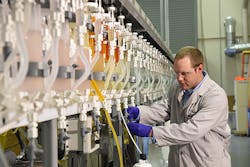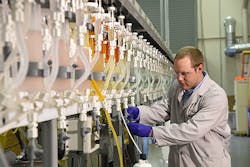DOE Touts “Game-Changing” Rare-Earth Elements Separation Technology
Kevin Lyon, an INL chemical engineer with expertise in applied solvent extraction, operates a counter-current solvent extraction system for testing and developing the process design for the separation technology.
A new technology for rare-earth elements chemical separation is licensed to Marshallton Research Laboratories, a North Carolina-based manufacturer of organic chemicals for a range of industries. Developed by scientists from Oak Ridge National Laboratory and Idaho National Laboratory in the Department of Energy’s Critical Materials Institute, or CMI, the technology provides insight into how to cost-effectively separate in-demand rare-earth elements, which could dramatically shift the industry to benefit producers in the United States.
The unique electronic properties of rare-earth elements, or REEs — a group of 17 metallic elements that includes 15 lanthanides plus yttrium and scandium — make them critical for producing electronics, optical technologies, alloys and high-performance magnets. These powerful, permanent magnets are vital to clean energy technology and defense applications.
Individual REEs do not occur in minable concentrations in the Earth’s crust but are naturally mineralized together and must be chemically separated to use for technological applications. Their physical and chemical similarities make them extremely difficult and costly to separate while generating a lot of waste. Extraction and separation of REEs for technological applications occurs largely overseas.
To meet the growing need for these materials and to limit the nation’s reliance on foreign sources, ORNL and INL scientists working under the banner of CMI, a DOE Energy Innovation Hub led by Ames Laboratory, have applied their deep expertise in chemical synthesis, separations, and engineering to design and produce new extraction agents based on diglycolamide, or DGA, ligands and a corresponding process for separating lanthanides that outperforms current technology.
“At Marshallton, our purpose is to become a domestic, strategically reliable supplier of DGA extractants for rare-earth elements. We expect to service pilot-plant and commercial operations in ore processing, recovery from mining tailings and recycling,” says Mac Foster, co-owner of Marshallton and a collaborator on the technology. “We’re excited to further explore what these new extractants can achieve.”
The work of the CMI team is outlined in Inorganic Chemistry. Co-authors include ORNL’s Santa Jansone-Popova, Bruce Moyer, Ilja Popovs, Camille Albisser, Vyacheslav Bryantsev, Mary Healy and Diana Stamberga; INL’s Lyon; Argonne National Laboratory’s Benjamin Reinhart; Foster of Marshallton Research Laboratories; and Alena Paulenova and Yana Karslyan, Oregon State University.
For more information, visit: www.ornl.gov

